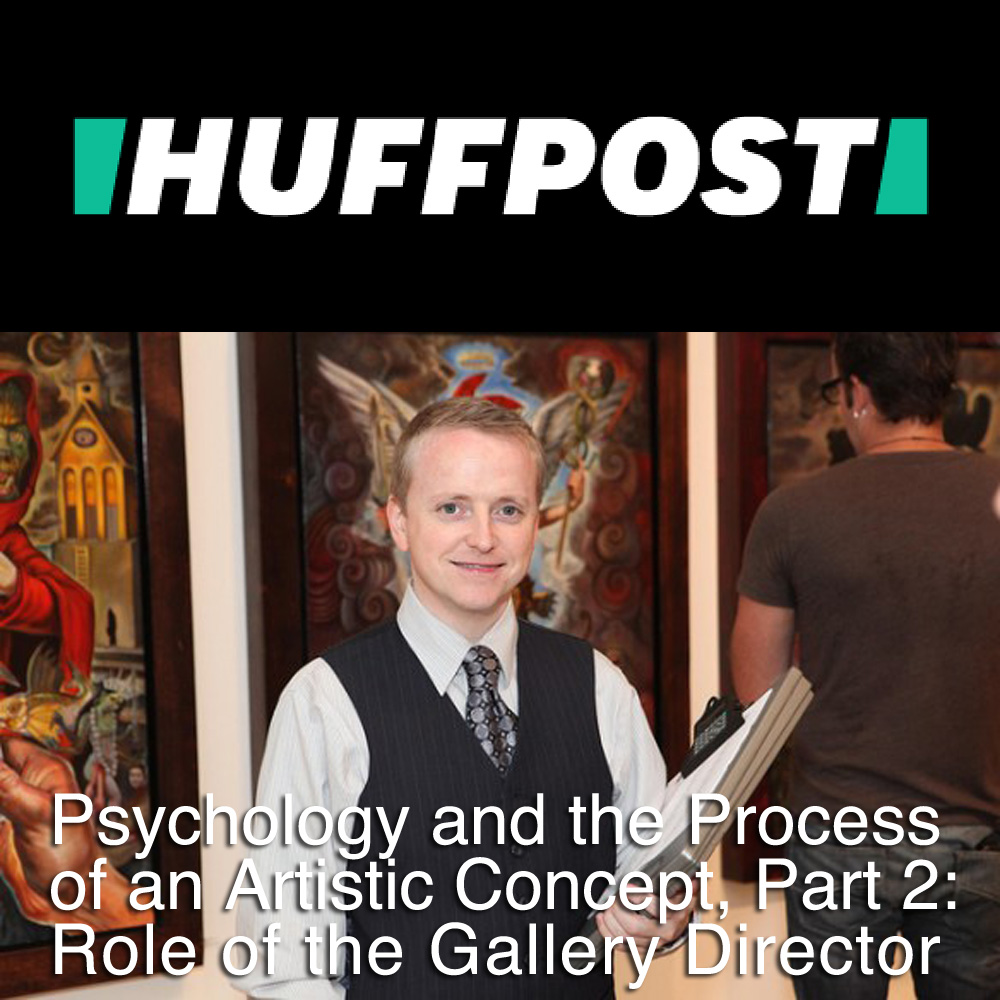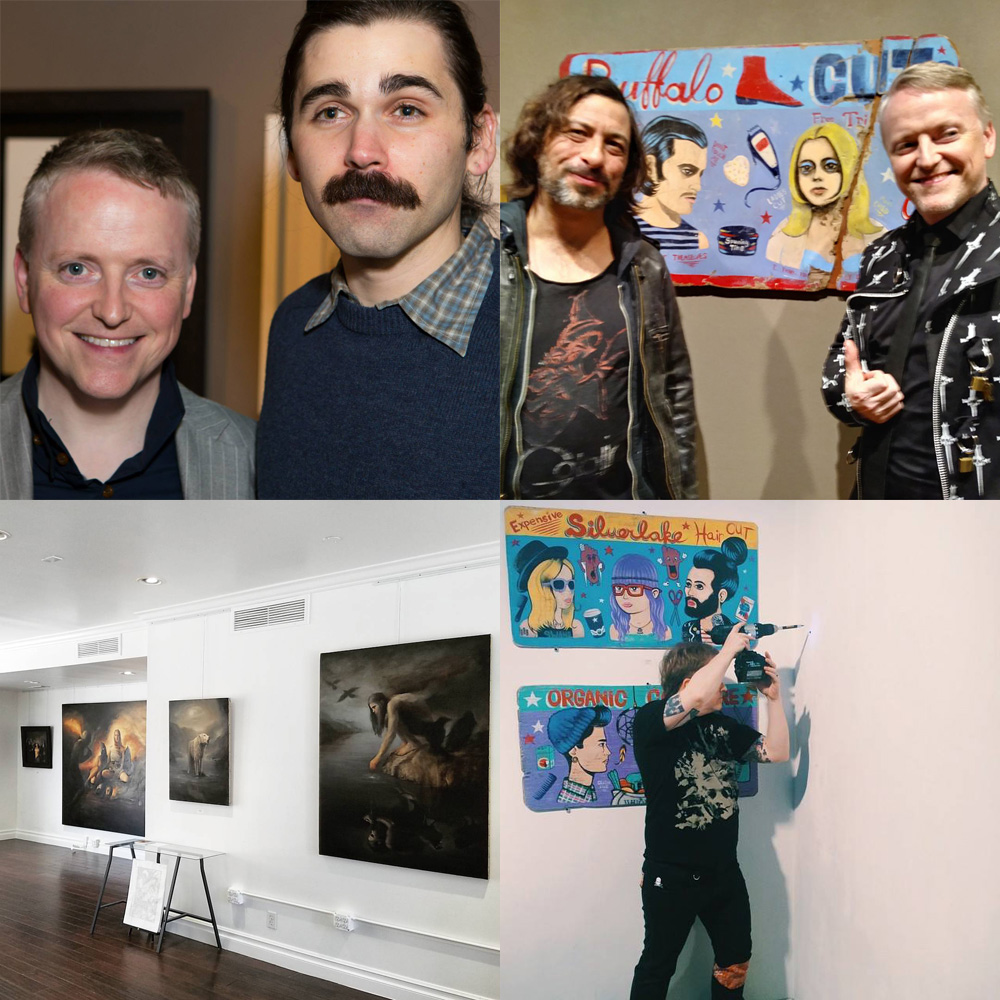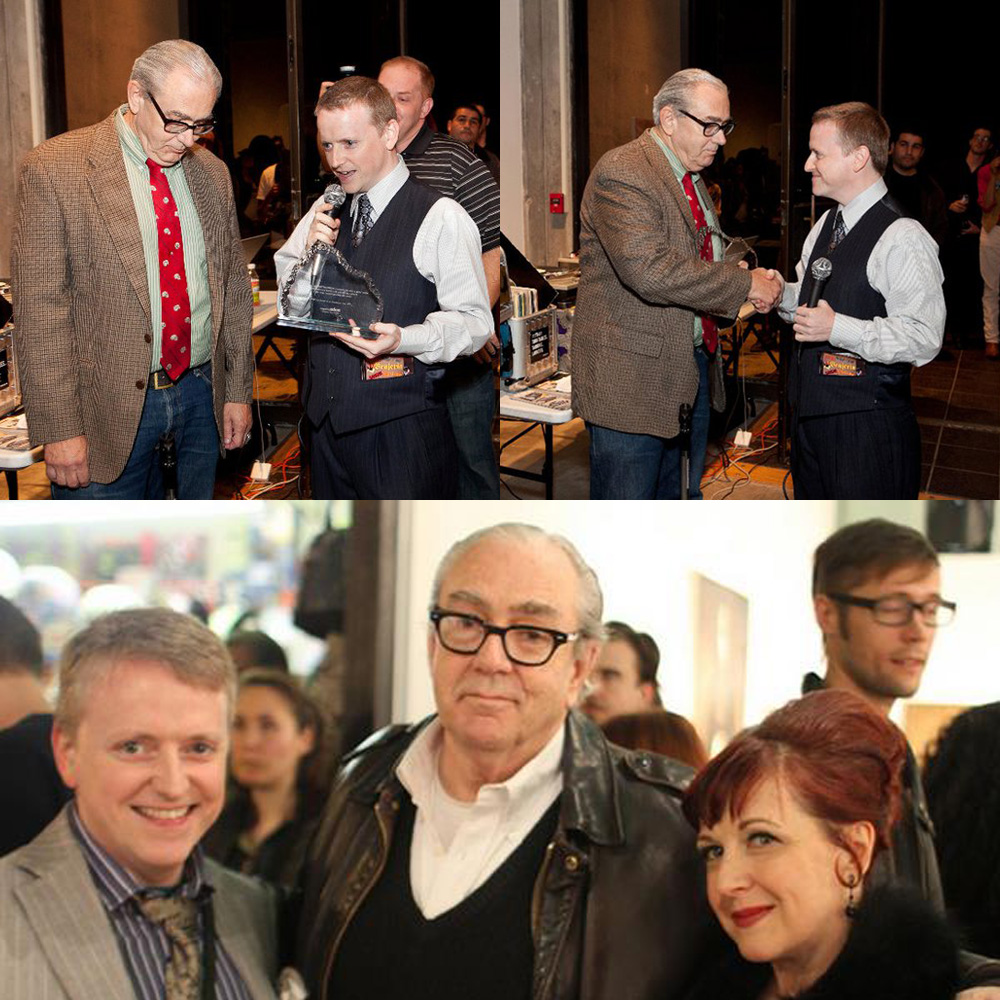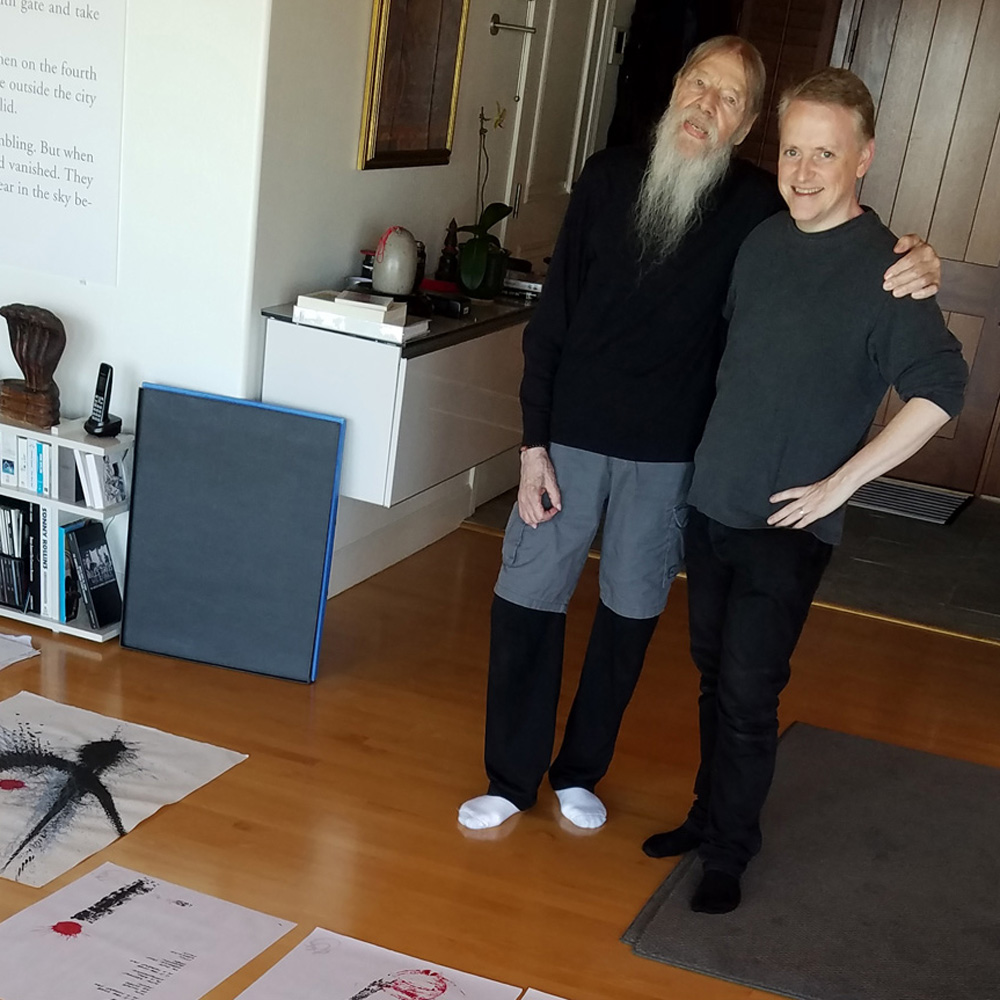
15 Jul Psychology and the Process of Artistic Concept
This interview with Gallery 30 South owner, Matt Kennedy, ran on the Huffington Post four years ago. As we emerge from one of the most challenging eras of our lifetime, this piece seemed especially pertinent –particularly in conjunction with the 9th Annual #CoasterShow (being juried now). Authored by Dr. Nikki Martinez as part of a series concerning the psychology of the artistic process, Matt was tapped to provide a gallerist’s perspective that is as relevant now as it was then:
I’ve been doing this long enough that I think I have a good idea of how far we can push the envelope, and certainly the crowd hasn’t always followed us as far out as we had hoped, but the requirements we’ve had of the work being both figurative and narrative allows for a wide range of styles and genres and we’ve earned a reputation for breaking new ground that our clientele seems to enjoy.

(Clockwise from left) Matt with Shaun Berke at the William Rolland Gallery and with Sean Stepanoff at his first solo exhibition (2014); installing the latter’s show at La Luz de Jesus; Berke’s “Mythos” at Gallery 30 South, 2017.
My involvement with each artist varies greatly from show to show. Sometimes I’ll give assignments, like with Sean Stepanoff I requested that he apply his comic, illustrated style to the Ghanaian barbershop sign but as a means of showcasing local and current pop culture in a semi-scathing way. That has become what he’s known for now. With Shaun Berke, it’s much more of a series of studio visits to select from multiple works-in-progress to help him decide which pieces to finish first as a looming deadline limits the number of oil paintings that can be finished in the allotted time.
Other times my interaction is limited to seeing someone’s work and asking them to deliver a certain number of pieces, or keeping to certain size and pricing requirements. With a few artists, I’ll recommend a musical playlist or film or book or lecture if it seems to fit with their theme. But it’s important to know that some artists have a very specific process, and sometimes that process doesn’t lend itself to collaboration. Sometimes that’s a good thing, but since this is a commercial gallery and not a museum the goal is to sell the art, not just showcase it. At La Luz De Jesus Gallery we didn’t show much high-concept art because it hasn’t historically performed well with our clientele. For me high concept needs to also be high craft, or it’s just not interesting to me.

Laluzapalooza 2016 artists’ reception and Temple of Art 2014 group photo.
If I’m concerned about my ability to sell an artists’ work I’ll get a good sense of what their boundaries are with a conversation, and if it doesn’t seem like a good fit, I’m not going to extend an invitation to feature them. There are many artists whose work I can easily sell, but with whom I have no interest in working. Neil Gaiman once said in a commencement speech that as a creative freelancer, if you are a pleasure to be around, always deliver on time, and have talent that you will always find employment, and any two of those things is generally good enough. As I get older, I want to deal with unpleasant and punctuality-challenged people less and less. Reliability is far and away the most important quality in this business, and second chances are rare.
The psychology involved with artists as it pertains to a gallery director’s relationship with an artist is not only going to be unique to each gallery but unique in each individual case. I don’t have a set-in-stone process that can be applied to everyone. If there was a sort of blanket method that could be utilized, I think we’d all be using it, but that sounds a bit bland. I don’t think that body language, speech or any other scientific criteria is going to tell me more than I can learn from a conversation with an artist about their work and their expectations. I know quickly whether I want I want to work with someone. It’s easy to figure out if someone is going to be hard to work with, and so if I identify that up front, and I still choose to work with them I have calculated the reward to be greater than the expense of mental energy. That reward need not be financial, it could be a spiritual reward, it could just be an exhibition I want to see realized.

Matt Kennedy presenting Robert Williams with a Lifetime Achievement Award at the Los Angeles Municipal Art Gallery in 2010 (top) and at La Luz de Jesus 25 in 2011 (bottom) with Lisa Petrucci.
Criticism must be solicited and it has to be constructive for it to succeed. If I get the sense that an artist can’t take criticism, I probably don’t want to work with them. To a lesser degree, an inability to take direction can be a handicap, but if an artist is following my every direction, why is it their name on the wall and not mine? I want to work with artists who have a clear vision, so that my job is to help find the right patron for that vision and to let them know if there are slight adjustments that make that easier to do. Sometimes the work is perfect but the audience hasn’t caught on yet. In some respect, what we strive for is to be as in-tune with the zeitgeist as possible because that’s financially lucrative, but that also runs the risk of being too reflective of the moment in which it was created. If an artist is mindful of legacy and still able to sell work, they can buy themselves a degree of freedom and stability that would otherwise be elusive.
As a gallery director, I sometimes serve as a placebo confidante, priest, rabbi, or therapist and I have absolutely had to talk artists off the proverbial ledge in the wee hours of the morning. I think that a lot of people would be surprised at how many actual life or death situations have hinged on the actions of a curator. And unfortunately, there are probably a lot of curators who just don’t grasp that responsibility. I don’t think that honesty needs to be brutal, and taste is so subjective that the notion of absolutes can change by postal address. I am generally careful to stress that I am only concerned with whether an artwork fits the space I curate and the program I have planned. That’s not to say something that doesn’t work here won’t work elsewhere, but that’s up to the artist to find in another opportunity. Quite often artists submit without reading submission guidelines or reply to courteous rejections with defensiveness or outright rudeness, which is self-destructive. Not everybody is talented, but not all successful artists are particularly talented, so I choose to address only whether a piece works for me.

Matt at a studio visit with Torben Ulrich, 2017
In a sense, emerging artists can be easier to work with because they haven’t developed many bad habits yet, but I prefer to work with art school kids because they’ve faced years of criticism and developed a thick skin. A lot of self-taught artists have only the feedback of family and friends, which is the least honest type of feedback and can lead to very bad decisions and misconceptions about the demand for the work. A few successes can turn a pleasant, punctual and talented artist into a lazy, unreliable jerk, but at a certain point the shortcomings edge into the work and the market notices and people either get back down to earth or fizzle out. That’s less common with institutionally educated artists. The biggest problem is when an artist confuses ego with integrity, because at the end of the day a gallery has final say over what hits their walls, and if the artist and gallery don’t have good communication… neither will be happy. I try to be clear about what is expected and address my expectations right up front, and I encourage artists to do the same. That’s worked out well for me thus far. In certain circles, I have a reputation for being able to work well with “difficult” people, but I certainly don’t go looking for difficult people to represent. Still, the track records speak for themselves, and my Coaster Show has launched literally thousands of careers.
Gallery 30 South was opened during my nearly ten-year tenure as director at La Luz de Jesus and it’s more of a personal space for my wife and I, where we get to be much more experimental. We’ve shown abstract expressionists, installation art, video and performance–all the things that wouldn’t work at La Luz de Jesus. I’ve been reaching out to mid and late career artists to generate a new context for their work, frequently pairing them with emerging artists in a kind of curated conversation. Many of my friends are better known for something aside from their visual art, and Gallery 30 South gives me a venue to present that work in the right environment as the new creative hub in Pasadena, which has an incredibly rich art history. Showcasing Torben Ulrich in November 2017, a multidisciplinary artist whose history can be traced back to the CoBrA happenings in the late 1940s (which he attended and where he sometimes performed in an improvisational jazz ensemble), was pivotal to launching my own gallery. It’s unfathomable to me that at 88 years old he’s remained such a well kept secret, and showcasing such important overlooked work is the realization of a dream for me. Isn’t that every gallerist’s dream?
Gallery 30 South accepts submissions for the Coaster Show from June to September only.
Click here for the Coaster Show Submission Policy
Click here to Browse the available coasters from last year’s show.
